Single-person households tipped to change Adelaide
A “startling” rise in single-person households and the trend toward flexible working arrangements will reshape how and where Greater Adelaide develops, state planning authorities predict.

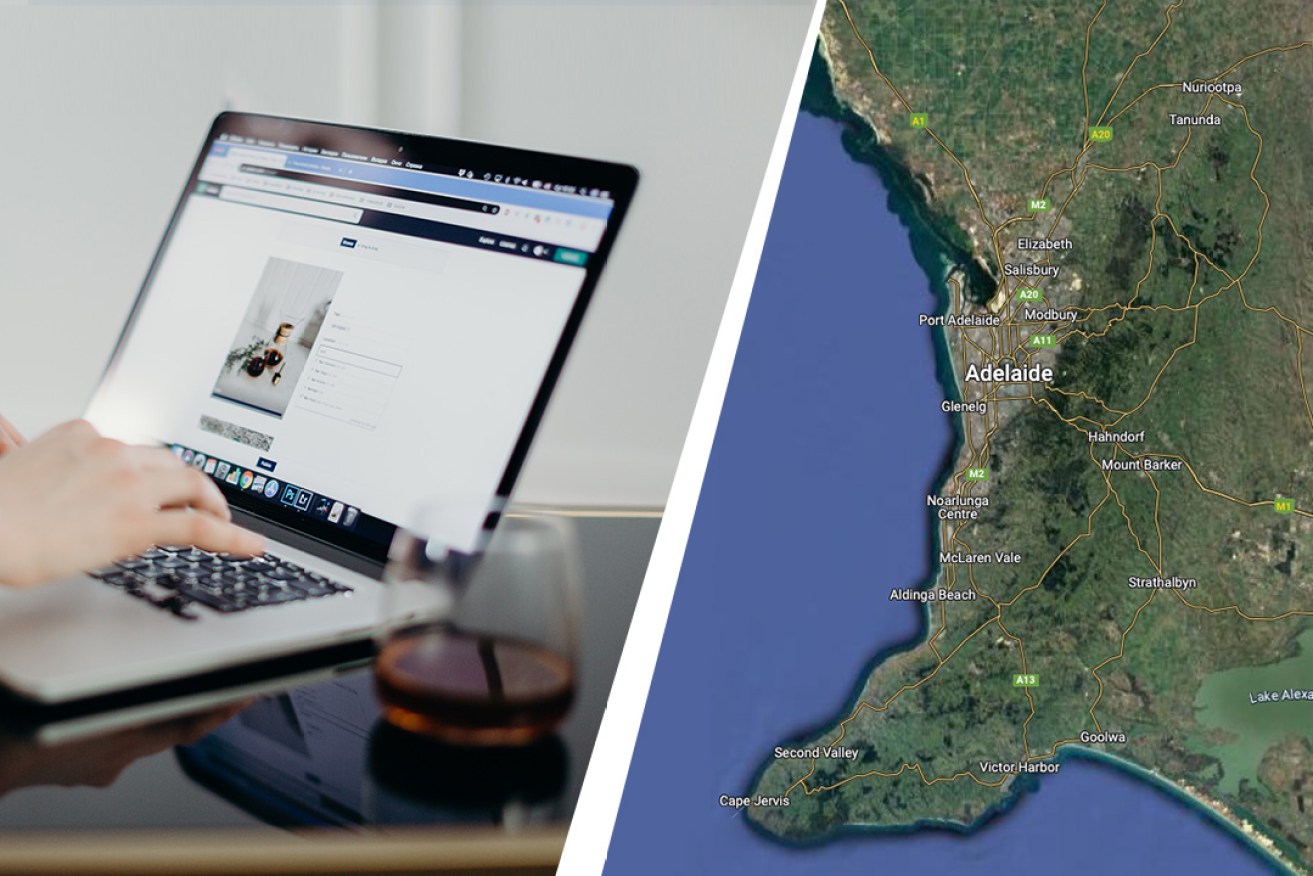
Images: Pexels and Google Maps
A 176-page discussion paper on next year’s Greater Adelaide Regional Plan points to a 78 per cent increase in single-person households over the last 30 years as a demographic trend that needs to be addressed in any planning.
“This is the main reason why housing demand now outstrips population growth,” the State Planning Commission paper states.
“If this trend continues, we will need an extra 300,000 homes over the next 30 years.”
These 300,000 new homes are needed to accommodate a potential 670,000 new residents by 2051, the paper outlines under a “high-growth scenario”.
“Census data reveals that the ongoing trend for detached dwellings – typically with three or more bedrooms – does not necessarily match the needs of increasing numbers of smaller households,” the paper continues.
“We need to encourage a broader range of dwelling types and dwelling sizes.”
At the 2021 Census, couples with children were still the most common type of household in Greater Adelaide, making up 28.6 per cent (158,479 households) of 553,824 total households.
However, the proportion of these family households has declined from 36.6 per cent to 28.6 per cent from 1991 to 2021, according to Australian Bureau of Statistics data compiled by data firm Informed Decisions.
In comparison, the proportion of single-person households has grown from 21.7 per cent to 26.8 per cent, with Greater Adelaide adding 63,649 single households between 1991 and 2021.
The next fastest-growing household category over that period is couples without children (+44,722) and one-parent families (+24,475).
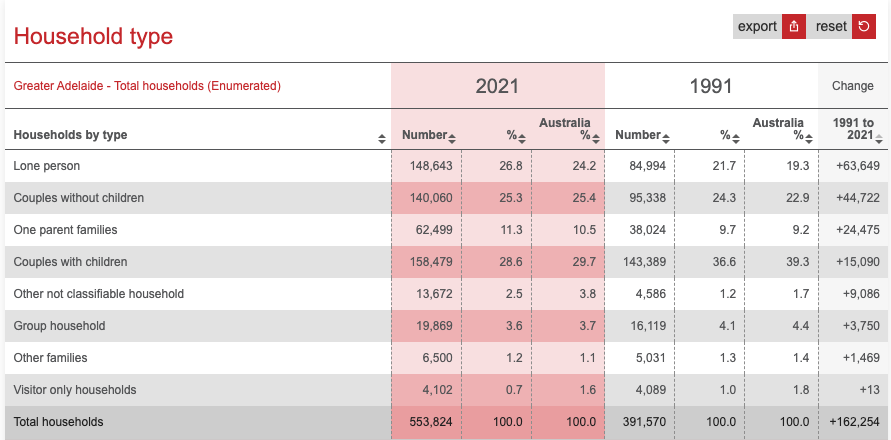
Table showing the growth in lone person, couples without children and one parent households in Greater Adelaide from 1991 to 2021. Table: Informed Decisions
Planning Minister Nick Champion said the rise in single-person households was “startling” and must be accounted for in planning policy.
“People have radically changed the way they’re living,” he told InDaily.
“When you get that on a macro level, it’s something we have to account for in our building policy and our planning policy because it’s a fundamental change in the amount of housing that has to go into the system.
“People often think it (housing supply issues) is driven by greed or by people having empty houses or by immigration, when in actual fact we’ve fundamentally changed as a society the way we live.
“And that household formation question is a big part of the analysis. If you’re having a sort of honest analysis or an honest community conversation, you’ve got to comprehend that – because otherwise people will leap to the wrong conclusions.”
Despite shrinking household sizes, the predominant form of housing choice in Greater Adelaide remains separate houses/detached dwellings, making up 73.3 per cent (435,311 dwellings) of the region’s housing mix at the 2021 census.
Medium-density housing only makes up 23.1 per cent (136,926 dwellings) while high-density accounts for just three per cent, well below the national average of 11 per cent and the Australian greater capital city average of 15.1 per cent.
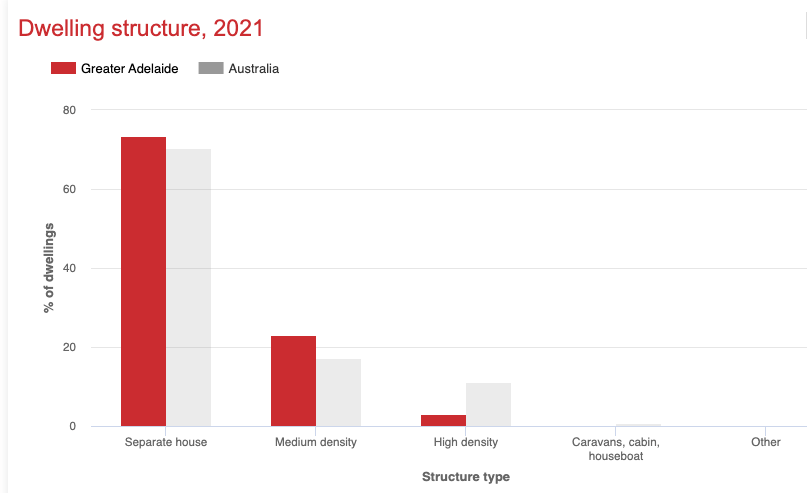
Greater Adelaide’s housing density compared to the Australian capital city average. Graph: Informed Decisions
State Planning Commission chair Craig Holden told InDaily there is a need for greater housing “choice”.
“We want it to be equitable and socially cohesive… we can’t drive all our workers further and further out beyond where they can afford to either rent or live,” Holden said.
“We know that if you work near the city, you’re near to transport, near the schools, hospitals, all those amenities.
“At the moment that’s for those with wealth, to be blunt, so we need more choice.
“So local councils do have to lift their game, and there’ll be parts of certain council areas, even the well-established ones, where we can have better density, and to meet the aspirations of people with one or two couples.”
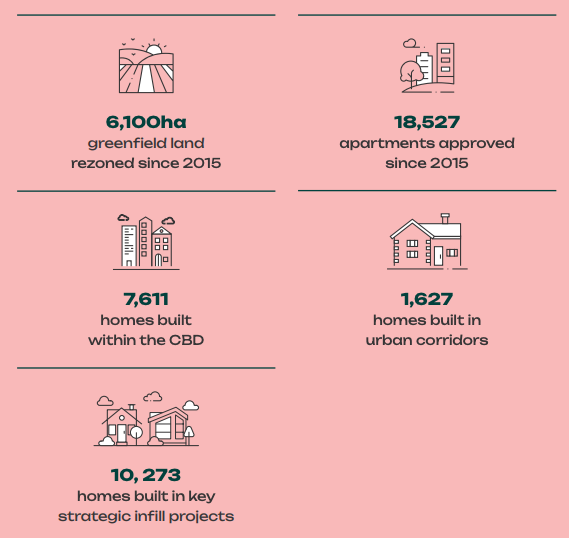
A snapshot of Greater Adelaide’s housing development since 2015. Photo: Greater Adelaide Regional Plan discussion paper
In March, Champion wrote to all 68 South Australian councils urging them to “proactively advocate” for land rezonings in their area, accusing some of “falling behind” on planning.
As InDaily reported on Tuesday, Champion also defends a need to build houses on vacant greenfield land despite planning academics arguing these developments have higher infrastructure costs and poorer environmental, health and public transport outcomes.
Planning targets set by the Rann and Weatherill governments to constrain Adelaide’s urban sprawl have also been scrapped by the Malinauskas Government.
The Planning Commission is now proposing investigating housing growth in greenfield and satellite city areas like Kudla, Roseworthy and Two Wells in Adelaide’s north as well as Murray Bridge, Victor Harbor and Goolwa.
Both Champion and Holden argue that investigating housing growth for these areas, despite their long distances from the CBD, is valid given the rise of hybrid working arrangements.
“The hybrid working from home world is here to stay,” Holden said.
“That’s the new world, the old concept of wherever I am I’ve got to get a bus to come to the city of Adelaide – that’s over, that’s gone.
“People live all over the place and work all over the place.”
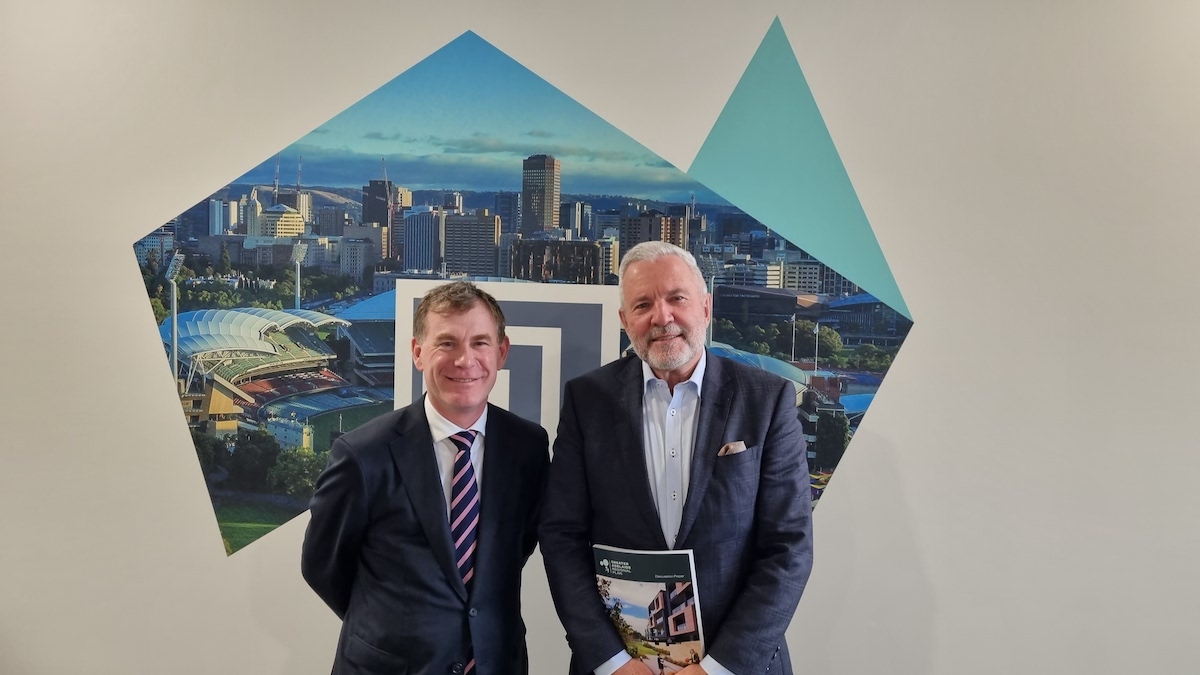
Planning Minister Nick Champion and Planning Commission chair Craig Holden. Photo: Thomas Kelsall/InDaily
South Australian workers spend less time working from home – an average of 1.42 days a week – than their eastern states counterparts, according to a University of Sydney survey released earlier this year.
The survey estimated 16.9 per cent of South Australian employees work from home, compared to a national average of 27 per cent.
But Champion argued that most state government departments now have work from home arrangements “in some shape or form”.
“It’s a productivity revolution. The other bit of this we haven’t sort of talked about it but it’s going to drive suburban growth – it already is,” he said.
“The drive of some of this work from home stuff, particularly in other cities, people don’t come to the city much.
“So that’s one of I guess the big challenges of repopulating the city.”
The Planning Commission’s discussion paper is also proposing major housing development – or “strategic infill” – opportunities in inner-city suburbs like Hindmarsh, Thebarton and Keswick.
The paper states that while the purchase price of homes in an established infill area “is often higher than in a greenfield development”, commuting and travel time costs can be 30 per cent less in middle ring suburbs and 60 per cent less in the CBD.
“In addition,” the paper states, “households in outer-suburban areas are not only likely to travel further to access services such as education, shops, and recreation, but they are also more vulnerable to car-related costs such as increasing petrol prices.”
Champion, who has asked critics of greenfield development to “tell me where else you would put the houses”, said strategic infill sites in the city are successful but require long-term planning.
“Bowden… started in 2011, finishes in 2030. It gives you an idea of those strategic infill sites how long they take to plan and develop but how successful they are.
“So, this plan is about setting us up for that next lot of challenges and looking at work from home, looking at the way the online retail revolution is going to affect the CBD, looking at… changes in the way people are living and working, because they are substantial.”
Public consultation on the Planning Commission’s discussion paper closes on November 6.




